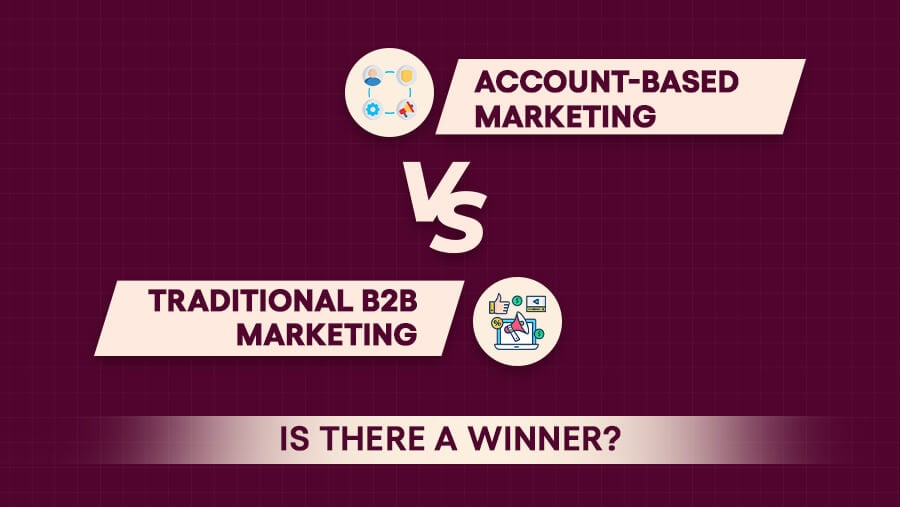
Account-based Marketing Vs. Traditional B2B Marketing: Is There a Winner?
As a B2B marketer, you constantly strive to reach your target audience effectively and efficiently. But with so many approaches, figuring out where to start can take time.
That's why it's essential to understand the critical differences between account-based marketing (ABM) and traditional B2B marketing.
A recent study found that 96% of B2B marketers who tried ABM have seen higher engagement rates than conventional approaches.
On the other hand, another study found that 46% of B2B marketers feel that traditional B2B marketing is the most effective approach.
The choice between account based marketing in B2B and traditional B2B marketing ultimately depends on your goals and target audience.
What Are the Key Differences Between Account-based and Traditional B2B Marketing?
ABM is a highly targeted and personalized approach focusing on specific accounts, while traditional B2B marketing targets a broader audience with a less customized methodology.
Read More: What Is an ABM List: 10-Step Guide for B2B Marketers.
Let's examine ABM and traditional B2B marketing in more detail to help you determine which approach is right for your promotional framework.

By understanding each approach's key differences and benefits, you can make an informed decision and choose the best strategy for your business.
1. Target Audience
ABM focuses on specific accounts and tailors its approach to meet its unique needs and goals.
On the other hand, traditional B2B marketing targets a broader audience and takes a mass-market approach.
2. Personalization
ABM is highly personalized, using account-specific data to deliver targeted and relevant messages to each account.
Traditional B2B marketing, however, is less customized and focuses more on overall messaging and branding.
3. Approach
ABM is a targeted and strategic approach that maximizes the impact on specific accounts.
In contrast, traditional B2B marketing takes a mass-market approach, reaching a wider audience with less personalization.
4. Measurement of Success
ABM measures success through account-specific metrics, such as increased engagement and conversion rates.
Traditional B2B marketing, on the other hand, focuses on overall campaign metrics, such as lead generation and cost per lead.
How Do ABM Funnels Differ from Regular B2B Marketing Funnels?
The Traditional Marketing Vs. ABM Funnel

In ABM, the focus is on specific accounts, and the demand generation process starts with identifying and targeting these accounts.
Instead of starting at the top with broad awareness campaigns, ABM commences at the bottom – concentrating on tailored efforts to engage and convert targeted customers.
The lead funnel in ABM is optimized for each account and designed to drive specific account-based metrics. Throughout the funnel, the emphasis is on delivering highly custom experiences and relevant content to each account.
In contrast, traditional B2B marketing focuses on a wider audience, and the demand generation process starts at the top – focusing on broad awareness promotions.
The lead funnel is optimized for the overall campaign, and success is measured through generic metrics.
What Are the Advantages of ABM
Why is B2B account based marketing important? To answer this question, let’s check out its main advantages:

1. Increased Engagement and Relevance
ABM focuses on specific accounts and delivers custom services, driving engagement and relevance. By tailoring your approach to meet each account's unique requirements and aims, you can achieve greater impact and results.
2. Better Alignment with Sales Teams
ABM aligns your marketing efforts with the sales team to target and engage specific accounts. This closer collaboration between marketing and sales leads to a more streamlined and effective process, helping to drive better outcomes.
3. Higher ROI
ABM has been shown to deliver a higher return on investment (ROI) compared to traditional B2B marketing. According to research by ITSMA, 87% of marketers who tracked their ROI ranked ABM as their top marketing investment.
This is because ABM focuses on high-value accounts with a higher probability of purchasing, leading to more effective use of marketing resources and a higher ROI.
What Are the Advantages of Traditional B2B Marketing?
Here they are…
1. Wider Reach
Traditional B2B marketing targets a broader audience, allowing you to reach more potential customers. This can be beneficial if you want to build brand awareness or generate leads on a larger scale.
2. Lower Cost Per Lead
Conventional promotional tactics typically have a lower cost per lead (CPL) than ABM. This is because they target a wider audience and don't require the same level of customization as ABM.
3. Flexibility
Traditional B2B marketing offers more flexibility. You can change your campaign anytime and adjust your approach based on performance. This level of flexibility can be beneficial if you need to respond quickly to market shifts or adapt your strategy based on results.
When Is ABM the Right Approach?
ABM is a targeted strategy that concentrates marketing efforts on a pre-selected set of target accounts instead of casting a wide net to reach a larger group of potential customers.
This approach is designed to be more customized and precise than traditional marketing methods.
Let's explore a few scenarios in which ABM can be particularly advantageous:
1. Limited Number of High-value Accounts
If your business has a small number of key accounts with high potential, ABM can effectively concentrate your marketing efforts on those accounts, thereby increasing the chances of success.
2. Highly Specialized Products and Services
ABM is an effective way to reach and educate your target audience about your business's specialized or complex product/service.
3. Long Sales Cycles
When your sales cycle is drawn out, ABM allows you to build relationships and nurture leads over time.
4. Customer Retention and Loyalty
ABM can also reinforce relationships with existing customers, increasing customer loyalty to your brand.
Account-based Marketing Examples That Generate Success
Here are a few examples of successful ABM campaigns:
- Tailored Email Outreach: A company can send targeted emails to specific accounts with custom messaging, offers, and content to engage and drive conversions.
- Personalized Webpages: A firm can create dedicated landing pages for targeted accounts with relevant messaging, discounts, and information to enhance conversions.
- Customized Direct Mail: A company can share personalized direct mail to specific accounts, with tailored messaging, deals, and materials–to engage them.
- Individualized Demonstrations: A firm can offer custom demos to targeted accounts to demonstrate the value of its product/service and improve conversions.
- Networking Events and Online Workshops: A company can organize events or host webinars for targeted accounts to showcase its product/service, provide industry-relevant insights, and interact with potential clients.
- Account-targeted Social Media Ads: A company can use social media advertising to reach targeted accounts and engage them with custom messaging, offers, and content.
When Is Traditional B2B Marketing the Right Approach

Traditional marketing refers to conventional advertising methods that have existed for an extended time.
Examples include television and radio ads, print ads (newspapers and magazines), direct mail, and outdoor ads (billboards).
There are several scenarios where traditional marketing proves helpful:
1. Targeting a Particular Group
Traditional marketing channels can be valuable in reaching specific demographics or locations. For instance, if you aim to get an older audience, consider using direct mail or print advertising.
2. Boosting Brand Recognition
Traditional marketing is a helpful tool for raising brand awareness, especially when paired with digital marketing efforts.
For example, a TV ad can reach a massive audience, leaving a lasting impression, and a social media campaign can help solidify the message and direct traffic to the company's website.
3. Supplementing Digital Marketing
Traditional marketing can enhance digital marketing efforts, such as providing a call to action that redirects consumers to a website or social media page.
4. Achieving Specific Objectives
Traditional marketing is ideal for reaching specific objectives, such as generating leads or increasing sales. For example, a direct mail campaign can target potential customers with exclusive offers or promotions.
Integrating ABM with Traditional B2B Marketing
Blending ABM and traditional marketing involves incorporating the targeted focus of ABM with the broader strategies of conventional marketing. The specific approach will vary based on the company's objectives and the accounts being targeted. Integration methods can include:
- Employing traditional marketing to generate interest among potential accounts and then utilizing ABM techniques to nurture leads and turn them into customers.
- Uniting the customization of ABM with the broad reach of traditional marketing approaches such as advertising and PR.
- Employing ABM to target specific accounts and industries and then using traditional marketing to reach a larger audience within those industries.
- Utilizing traditional marketing to drive traffic and leads to a company's website or landing pages, followed by using ABM to convert those leads into customers.
By integrating ABM and traditional marketing, companies can develop more effective and personal campaigns that generate results and achieve their business objectives.
Related Post: How to Choose a B2B ABM Agency?
Final Word
ABM concentrates on specific companies or accounts rather than a large audience. It’s a more customized and personal way to approach marketing.
Unlike conventional marketing, which aims to reach a broad group of potential customers with tactics like ads, email campaigns, and events, ABM enables marketers to create messages and campaigns that cater to a selected account's specific needs and preferences.
The collaboration between sales and marketing teams is also different in ABM. In this approach, the teams select key accounts and design campaigns accordingly.
In traditional marketing, however, the sales and marketing teams may have separate goals and methods that are only sometimes aligned.
ABM is also more data-oriented and can be easily measured, enabling marketers to assess their campaigns' effectiveness on specific accounts. This provides valuable feedback and the ability to make adjustments on the go.
In conclusion, ABM is a more personalized and targeted marketing method, ideal for companies looking to establish strong connections with key accounts and increase revenue. Blending ABM with a traditional marketing approach can significantly increase your organization’s growth.
For Further Reading: Advantages of ABM Agency Partners




